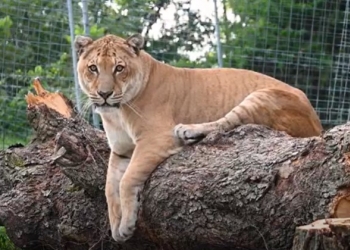News
Regional News
Posted: Oct 16, 2022 2:36 PMUpdated: Oct 16, 2022 2:36 PM
Turpentine Creek Wildlife Refuge Partners with Breast Cancer Research Foundation

Tom Davis
October is Breast Cancer Awareness Month. Most people are familiar with the iconic pink ribbon symbolizing this international health campaign and worldwide support for this life-saving initiative. This entire month is dedicated to increasing awareness of the disease, promoting self-checks and mammography for early detection, and helping to raise funds for research for treatment and cures. With more than 200,000 cases diagnosed each year in the United States, many of us have been affected by this disease in some way. Unfortunately, other mammals are not spared from this disease either. In domestic cats, mammary cancer accounts for nearly one-third of all diagnosed feline tumors, and 90% are a very aggressive form known as mammary carcinoma or adenocarcinoma. On Friday, September 30, Turpentine Creek Wildlife Refuge (TCWR) lost a much-loved resident, Mani, to a fight with breast cancer.
Mani was a liger, the result of a male lion bred with a female tiger, rescued in 2021 from Tiger King Park. The Netflix documentary, Tiger King, went viral in early 2020, shining a spotlight on the key players and animal abusers within the Big Cat trade. Turpentine Creek Wildlife Refuge, fully accredited by the Global Federation of Animal Sanctuaries (GFAS) and a founding member of the Big Cat Sanctuary Alliance (BCSA), was one of the go-to sanctuarie called upon by the Department of Justice (DOJ) to assist in the seizure of 68 big cats from the Tiger King Park in Thackerville, Oklahoma in May of 2021. This covert operation was coordinated by the DOJ, BCSA, and the President of Turpentine Creek Wildlife Refuge, Tanya Smith, in a two-part execution that included SWAT teams and armored vehicles. As a Tiger King Park survivor, Mani was bred to other lions and tigers to produce hybrid cubs for cub petting and/or as future breeding stock.
Mani was in reasonably good health at the time of her rescue, and she adjusted well to her new life at Turpentine Creek Wildlife Refuge. In June of this year, TCWR staff immobilized Mani and performed her first hands-on full wellness examination. This examination is the equivalent of a complete physical humans have done annually. During the full wellness exam, the cats are weighed, x-rays are taken, teeth cleaned, claws trimmed, and bloodwork is drawn and tested. During Mani's exam, multiple large tumors were discovered in her left mammary chain. A biopsy was performed, revealing that the cancer was growing so fast that the center of the tumor was dying and had leaked what is called necrotic fluid. A histopathology exam confirmed that Mani was dealing with mammary carcinoma.
After consulting with peer veterinary oncologists, TCWR staff veterinarian Dr. Kellyn Sweeley, DVM, determined that the aggressive step of performing surgery to remove Mani's entire left mammary chain with all associated glands wasunlikely to increase her survival time. Such an extensive surgery could decrease her remaining quality of life due to the size of the resultant incision and increased risk of infection or dehiscence (incision reopening). However, as the tumors were so large and necrotic in the center, with an eventual probability of bursting and creating large open wounds, it was determined Mani would benefit from having the tumors removed. In July, Mani underwent lumpectomy surgery to remove the tumors and their surrounding mammary gland tissue. While the lumpectomy would not increase Mani' survival time, it would improve her quality of life by minimizing the pain and the secondary effects that ulcerated tumors can cause. The surgery was also critically important because the cancer was located near Mani's lymph nodes. Once in the lymphatic system, her survival rate would drastically decrease. Unfortunately, it was discovered on surgical removal that cancer had already spread to the surrounding lymph nodes.
Turpentine Creek Wildlife Refuge follows a modern animal welfare concept called the Five Domains Model. This is a science-based structure for assessing animal welfare, recognizing that animals can experience negative and positive feelings. The Five Domains are Nutrition, Environment, Health, Behavior, and Mental. The Model allows the team to minimize negative experiences and increase positive experiences to ensure the highest welfare for the remainder of the animals’ life. Over the past two months, Mani slowly increased her water intake as her appetite decreased.
To help tell Mani's story, Turpentine Creek created Mani Breast Cancer Awareness Pins for October with plans to share her story and help raise money for the Breast Cancer Research Foundation. In a beautiful ending, Mani was humanely euthanized the morning of September 30, and her pins arrived at the Refuge later that same afternoon – one day before October 1st, the start of Breast Cancer Awareness Month. Hearts were heavy as the team said farewell to this brave fighter.
Her story will continue to be shared, and through her story, Turpentine Creek Wildlife Refuge hopes to continue to do good for animals and humans alike. For every Mani Breast Cancer Awareness Pin sold, $1 of the sale will go back to the Breast Cancer Research Foundation.
If you’d like to help Turpentine Creek Wildlife Refuge and the Breast Cancer Research Foundation, please consider visiting the online store at www.turpentinecreek.org to purchase one of Mani’s pins or buy one in person by visiting the Refuge.
« Back to News















